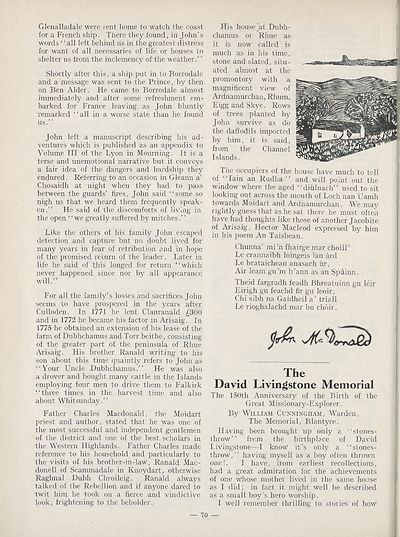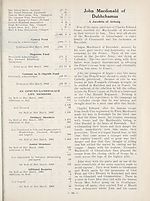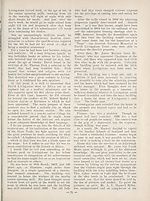An Comunn Gàidhealach Publications > Gaidheal > Volumes 58--62(part), January, 1963--March 1967
(100) Page 70
Download files
Complete book:
Individual page:
Thumbnail gallery: Grid view | List view

Glenalladale were ient home to watch the coast
for a French ship. There they found, in John’s
words ‘ ‘ all left behind us in the greatest distress
for want of all necessaries of life or houses to
shelter us from the inclemency of the weather.’ ’
Shortly after this, a ship put in to Borrodale
and a message was sent to the Prince, by then
on Ben Alder. He came to Borrodale almost
immediately and after some refreshment em¬
barked for France leaving as John bluntly
remarked “all in a worse state than he found
us.’ ’
John left a manuscript describing his ad¬
ventures which is published as an appendix to
Volume III of the Lyon in Mourning. It is a
terse and unemotional narrative but it conveys
a fair idea of the dangers and hardship they
endured. Referring to an occasion in Gleann a’
Chosaidh at night when they had to pass
between the guards’ fires, John said “some so
nigh us that we heard them frequently speak-
en.’’ He said of the discomforts of living in
the open ‘ ‘ we greatly suffered by mitches.’ ’
Like the others of his family John escaped
detection and capture but no doubt lived for
many years in fear of retribution and in hope
of the promised return of the leader. Later in
life he said of this longed for return “which
never happened since nor by all appearance
will.’’
For all the family’s losses and sacrifices John
seems to have prospered in the years after
Culloden. In 1771 he lent Clanranald ^300
and in 1772 he became his factor in Arisaig. In
1775 he obtained an extension of his lease of the
farm of Dubhchamus and Torr beithe, consisting
of the greater part of the peninsula of Rhue
Arisaig. His brother Ranald writing to his
son about this time quaintly refers to John as
“Your Uncle Dubhchamus.’’ He was also
a drover and bought many cattle in the Islands
employing four men to drive them to Falkirk
“three times in the harvest time and also
about Whitsunday.’’
Father Charles Macdonald, the Moidart
priest and author, stated that he was one of
the most successful and independent gentlemen
of the district and one of the best scholars in
the Western Highlands. Father Charles made
reference to his household and particularly to
the visits of his brother-in-law, Ranald Mac-
donell of Scammadale in Knoydart, otherwise
Raghnal Dubh Chroileig. Ranald always
talked of the Rebellion and if anyone dared to
twit him he took on a fierce and vindictive
look, frightening to the beholder.
His house [at Dubh¬
chamus or Rhue as
it is now called is
much as in his time,
stone and slated, situ¬
ated almost at the
promontory with a
magnificent view of
Ardnamurchan, Rhum,
Eigg and Skye. Rows
of trees planted by
John survive as do
the daffodils imported
by him, it is said,
from the Channel
Islands.
The occupiers of the house have much to tell
of “Iain an Rudha ’’ and will point out the
window where the aged ‘ ‘ diulnach’ ’ used to sit
looking out across the mouth of Loch nan Uamh
towards Moidart and Ardnamurchan. We may
rightly guess that as he sat there he must often
have had thoughts like those of another Jacobite
of Arisaig, Hector Macleod expressed by him
in his poem An Taisbean.
Chunna’ mi’n fhairge mar choill’
Le crannaibh loingeis lan ard
Le brataichean anasach ur,
Air learn gu’m b’ann as an Spainn.
Theid fargradh feadh Bhreatuinn gu leir
Eirigh gu feachd fir gu leoir,
Chi sibh na Gaidheil a’ trial!
Le rioghalachd mar bu choir.
The
David Livingstone Memorial
The 150th Anniversary of the Birth of the
Great Missionary-Explorer.
By William CuKningham, Warden,
The Memorial, Blantyre.
Having been brought up only a “stones-
throw’’ from the birthplace of David
Livingstone—I know it’s only a “stones-
throw,’’ having myself as a boy often thrown
one!. I have, from earliest recollections,
had a great admiration for the achievements
of one whose mother lived in the same house
as I did; in fact it might Well be described
as a small boy’s hero worship.
I well remember thrilling to stories of how
— 70 —
for a French ship. There they found, in John’s
words ‘ ‘ all left behind us in the greatest distress
for want of all necessaries of life or houses to
shelter us from the inclemency of the weather.’ ’
Shortly after this, a ship put in to Borrodale
and a message was sent to the Prince, by then
on Ben Alder. He came to Borrodale almost
immediately and after some refreshment em¬
barked for France leaving as John bluntly
remarked “all in a worse state than he found
us.’ ’
John left a manuscript describing his ad¬
ventures which is published as an appendix to
Volume III of the Lyon in Mourning. It is a
terse and unemotional narrative but it conveys
a fair idea of the dangers and hardship they
endured. Referring to an occasion in Gleann a’
Chosaidh at night when they had to pass
between the guards’ fires, John said “some so
nigh us that we heard them frequently speak-
en.’’ He said of the discomforts of living in
the open ‘ ‘ we greatly suffered by mitches.’ ’
Like the others of his family John escaped
detection and capture but no doubt lived for
many years in fear of retribution and in hope
of the promised return of the leader. Later in
life he said of this longed for return “which
never happened since nor by all appearance
will.’’
For all the family’s losses and sacrifices John
seems to have prospered in the years after
Culloden. In 1771 he lent Clanranald ^300
and in 1772 he became his factor in Arisaig. In
1775 he obtained an extension of his lease of the
farm of Dubhchamus and Torr beithe, consisting
of the greater part of the peninsula of Rhue
Arisaig. His brother Ranald writing to his
son about this time quaintly refers to John as
“Your Uncle Dubhchamus.’’ He was also
a drover and bought many cattle in the Islands
employing four men to drive them to Falkirk
“three times in the harvest time and also
about Whitsunday.’’
Father Charles Macdonald, the Moidart
priest and author, stated that he was one of
the most successful and independent gentlemen
of the district and one of the best scholars in
the Western Highlands. Father Charles made
reference to his household and particularly to
the visits of his brother-in-law, Ranald Mac-
donell of Scammadale in Knoydart, otherwise
Raghnal Dubh Chroileig. Ranald always
talked of the Rebellion and if anyone dared to
twit him he took on a fierce and vindictive
look, frightening to the beholder.
His house [at Dubh¬
chamus or Rhue as
it is now called is
much as in his time,
stone and slated, situ¬
ated almost at the
promontory with a
magnificent view of
Ardnamurchan, Rhum,
Eigg and Skye. Rows
of trees planted by
John survive as do
the daffodils imported
by him, it is said,
from the Channel
Islands.
The occupiers of the house have much to tell
of “Iain an Rudha ’’ and will point out the
window where the aged ‘ ‘ diulnach’ ’ used to sit
looking out across the mouth of Loch nan Uamh
towards Moidart and Ardnamurchan. We may
rightly guess that as he sat there he must often
have had thoughts like those of another Jacobite
of Arisaig, Hector Macleod expressed by him
in his poem An Taisbean.
Chunna’ mi’n fhairge mar choill’
Le crannaibh loingeis lan ard
Le brataichean anasach ur,
Air learn gu’m b’ann as an Spainn.
Theid fargradh feadh Bhreatuinn gu leir
Eirigh gu feachd fir gu leoir,
Chi sibh na Gaidheil a’ trial!
Le rioghalachd mar bu choir.
The
David Livingstone Memorial
The 150th Anniversary of the Birth of the
Great Missionary-Explorer.
By William CuKningham, Warden,
The Memorial, Blantyre.
Having been brought up only a “stones-
throw’’ from the birthplace of David
Livingstone—I know it’s only a “stones-
throw,’’ having myself as a boy often thrown
one!. I have, from earliest recollections,
had a great admiration for the achievements
of one whose mother lived in the same house
as I did; in fact it might Well be described
as a small boy’s hero worship.
I well remember thrilling to stories of how
— 70 —
Set display mode to:
![]() Universal Viewer |
Universal Viewer | ![]() Mirador |
Large image | Transcription
Mirador |
Large image | Transcription
| An Comunn Gàidhealach > An Comunn Gàidhealach Publications > Gaidheal > Volumes 58--62(part), January, 1963--March 1967 > (100) Page 70 |
|---|
| Permanent URL | https://digital.nls.uk/127149981 |
|---|
| Description | This contains items published by An Comunn, which are not specifically Mòd-related. It includes journals, annual reports and corporate documents, policy statements, educational resources and published plays and literature. It is arranged alphabetically by title. |
|---|
| Description | A collection of over 400 items published by An Comunn Gàidhealach, the organisation which promotes Gaelic language and culture and organises the Royal National Mòd. Dating from 1891 up to the present day, the collection includes journals and newspapers, annual reports, educational materials, national Mòd programmes, published Mòd literature and music. |
|---|---|
| Additional NLS resources: |
|

